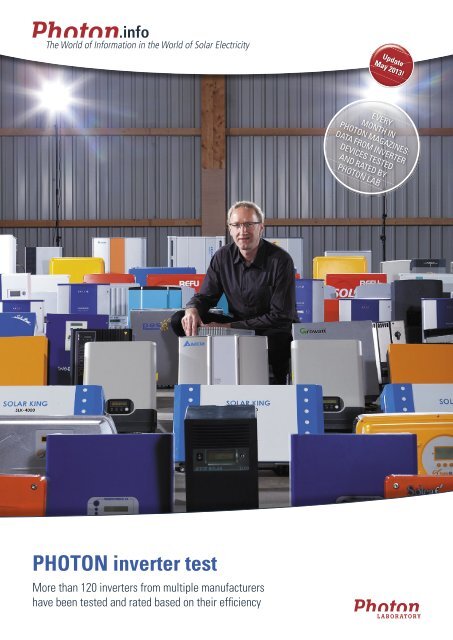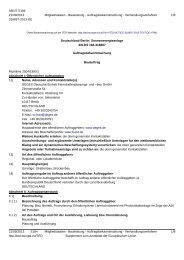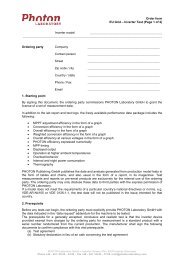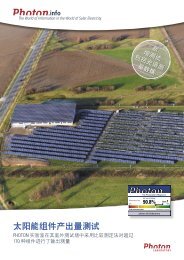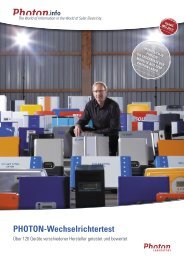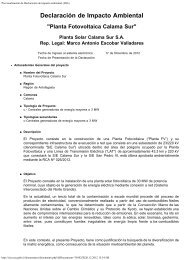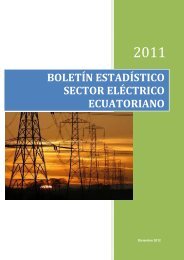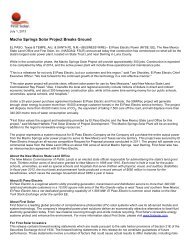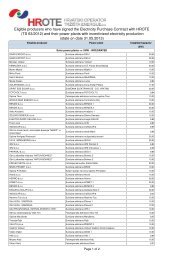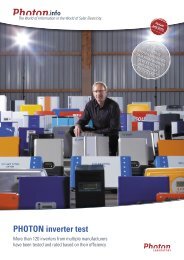PHOTON inverter test - PHOTON Info
PHOTON inverter test - PHOTON Info
PHOTON inverter test - PHOTON Info
- No tags were found...
Create successful ePaper yourself
Turn your PDF publications into a flip-book with our unique Google optimized e-Paper software.
UpdateMay 2013!EVERYMONTH IN<strong>PHOTON</strong> MAGAZINES:DATA FROM INVERTERDEVICES TESTEDAND RATED BY<strong>PHOTON</strong> LAB<strong>PHOTON</strong> <strong>inverter</strong> <strong>test</strong>More than 120 <strong>inverter</strong>s from multiple manufacturershave been <strong>test</strong>ed and rated based on their efficiency
<strong>PHOTON</strong> LaboratoryAbout usAt <strong>PHOTON</strong> Lab, we have beencarrying out <strong>inverter</strong> <strong>test</strong>ssuccessfully since 2007, informing<strong>PHOTON</strong> readers whether ornot a device is up to snuff. Gradesranging from A++ to F, whichcorrespond to an overall efficiencydefined by <strong>PHOTON</strong>, are assignedto enable better comparison of themultitude of devices.Since the beginning of 2007, we at <strong>PHOTON</strong>Lab have employed our own <strong>inverter</strong> <strong>test</strong>methodology. In agreement with our <strong>test</strong>partners, the <strong>test</strong> results are regularly published in<strong>PHOTON</strong> magazines. To make these results easier tocomprehend, the editorial staff, drawing its inspirationfrom school report cards, launched a grading systemwith its own <strong>test</strong>ing certificates: grades rangefrom A++ to F.Each month, over 200,000 planners, decision makersand operators of PV systems trust in the resultsof our lab <strong>test</strong>s. Our experts are working continuouslyon better <strong>test</strong> methods for even more significantresults. Our lab is respected for its independent andreliable <strong>test</strong>s. Benefit from our expertise and let us<strong>test</strong> your <strong>inverter</strong>.To assign a grade, we first need to determine theefficiency to which the grade refers. Both peak efficiencyand European efficiency aren‘t well-suited forthis purpose. That is why we decided to define ourown efficiency value, the value of which far exceedsconventional efficiency data (see box, p. 5).In our lab, we <strong>test</strong> serial and pre-serial grid-tied<strong>inverter</strong>s with EU-standard. The results of the preserial<strong>inverter</strong>s will not be published but can be usedby the manufacturers to optimize their products. Theresults of the serial <strong>inverter</strong>s are usually published by<strong>PHOTON</strong>. Furthermore the manufacturer will receivea <strong>test</strong> report and a <strong>test</strong> logo. Naturally, releasing <strong>test</strong>results in <strong>PHOTON</strong> magazines is an efficient – andeditorial-based – measure for manufacturers to buildtrust among customers.Heinz NeuensteinHead of laboratory (<strong>inverter</strong>s & system components)Rolf Schulten / photon-pictures.comCheck the monthly <strong>test</strong> results in:• <strong>PHOTON</strong> – Das Solarstrom-Magazin (German)• <strong>PHOTON</strong> Profi – Photovoltaik-Fachwissen für die Praxis (German)• <strong>PHOTON</strong> – Il Mensile del Fotovoltaico (Italian)• <strong>PHOTON</strong> International – The Solar Power Magazine (English)• <strong>PHOTON</strong> International – (Chinese)Every month in <strong>PHOTON</strong> magazines: Data from <strong>inverter</strong>s <strong>test</strong>ed and rated by <strong>PHOTON</strong> Lab.2Laboratory
How <strong>PHOTON</strong> conducts its <strong>test</strong>Steca Elektronik GmbHInverters in serial production: <strong>PHOTON</strong> Lab selects <strong>test</strong> devices randomly from a list of a hundred consecutiveserial numbers.Our goal: Helping system operatorsselect the right <strong>inverter</strong>s.Since the beginning of 2007, we at <strong>PHOTON</strong>Lab have employed our own <strong>inverter</strong> <strong>test</strong>methodology. In agreement with our <strong>test</strong>partners, the <strong>test</strong> results are regularly publishedin <strong>PHOTON</strong> magazines. To make these results easierto comprehend, the editorial staff, drawing itsinspiration from school report cards, launched agrading system with its own <strong>test</strong>ing certifi cates:grades range from A to F. The highest grade (»A«)has three different levels: an A grade, an A+ or anA++. An F grade is assigned to an <strong>inverter</strong> with aneffi ciency so poor that it‘s essentially not worththe money paid for it. In this sense, devices likethese are too expensive to even give away. Toassign a grade, we fi rst need to determine theeffi ciency to which the grade refers. Both peakeffi ciency and European effi ciency aren‘t wellsuitedfor this purpose. That is why <strong>PHOTON</strong> decidedto defi ne its own effi ciency value, the valueof which far exceeds conventional effi ciencydata (see box p. 5). Furthermore, the goal of thisgrading system is to enable better comparisonsof individual devices.The grades provided in the survey can essentiallybe associated with the devices‘ overallutility, which is often diffi cult to determine forLaboratory3
<strong>PHOTON</strong> Laboratoryinstallers, wholesalers, systemoperators, insurance companiesand banks. To give readers of our<strong>inverter</strong> <strong>test</strong> an immediate senseof a device‘s value, we assign asingle grade for both medium andhigh irradiation to each <strong>inverter</strong>that takes into account all relevantfactors such as an <strong>inverter</strong>'s efficiencydependence on input voltage,the suggested MPP operating point,information on the input current limitationon the operating point, andthe relation between temperatureand conversion efficiency. No otherindividual scores have an influenceon the grade. The parameters reflectedin the grade are reviewed onan annual basis and are discussedwith manufacturers in advance.The total grade is based on twocriteria: the assessment of the efficiencydetermined by <strong>PHOTON</strong> andthe temperature-related reductionof efficiency. The grade for this efficiencyis assigned without any differentiationbased on the suitabilityof the <strong>inverter</strong>s' use with a particularsolar generator. The best device isthe one with the highest efficiencyindependent of whether or not it haspotential separation, is exclusively designed foruse indoors or outdoors, or has a broad voltagerange. In the meantime, there are now suitabletransformerless <strong>inverter</strong> topologies for all knownmodule types. Only the conversion efficiency‘stemperature interdependency has a relevant influenceon the grade. Furthermore, we provideinformation on the <strong>inverter</strong>‘s efficiency at 25 °Cand the maximum temperature before any powerreduction is detected. Both values are subtractedfrom one another. If the resulting efficiency reductionreaches or exceeds the difference from thenext, lower grade (for example, there‘s a 1.5 gapbetween »B« and »C«), the device receives the lowergrade (i.e. »C«).The question of whether an <strong>inverter</strong> is wellsuitedfor use with a particular module type isbest answered by the manufacturer, but our <strong>test</strong>sshould provide some guidance. For instance, theconnections of some thin-film module types cannotbe charged with negative potential againstthe ground. A few crystalline high-power modulesrequire a high-impedance ground at the DC connectionto avoid polarization effects. We requestapproval from the manufacturers of these moduletypes for the <strong>inverter</strong> under examination. As amatter of principle, the <strong>inverter</strong> input‘s potentialin relation to the ground has to be known.Naturally, our lab also measures the efficiencyand the MPPT adjustment efficiency, both basedon the specified P MPPpower – the product of whichis the overall efficiency. This is then applied acrossall the measured input voltages to establish theA thermographic image shows temperature hotspots within an <strong>inverter</strong>. Naturally,these hotspots can be critical for the long-term performance of a device.average at each power level. This average is thenweighted according to European and Californianefficiencies, and included in the evaluation. Theoverall efficiency is based on Heinrich Häberlin‘sdefinition of »total efficiency,« which is describedin his book on the efficiency of PV <strong>inverter</strong>s publishedin 2005.The <strong>PHOTON</strong> efficiency for medium and highirradiation levels is an artificial value that representsan image of the voltage and power interdependenciesof an <strong>inverter</strong>‘s efficiency. The Europeanand Californian weighting system revealsthe dependence of the average overall efficiencyon the geographic latitude at which the PV systemis installed. This dependency is expressedwith different weighting factors that result fromthe inclusion of meteorological data. This data allowsthe <strong>test</strong>ers to make frequency distributionsfor certain solar irradiation values, which in turnprovide weighting factors for particular power levels.The innovative part of the calculations usedto establish the <strong>PHOTON</strong> efficiency parametersis that it includes all measured input voltages asspecified in the manufacturer‘s description of thedevice‘s input voltage range – even if the devicecannot perform as required in all parts of this range,in which case the efficiency is then listed as 0percent. This reflects the conditions of a real PVsystem: after all, if an <strong>inverter</strong> had to face theseconditions, it would cease operating properly.The graphical representation shows these areas.For instance, the color diagram included inour <strong>inverter</strong> <strong>test</strong>s shows the <strong>inverter</strong>‘s efficiency,the MPPT adjustment efficiency and theoverall efficiency. The diagram is coloredblack if the maximum MPP voltage isn‘tadequately distanced from the <strong>inverter</strong>‘smaximum DC voltage, and if it doesn‘thave an active overload limit accordingto the manufacturer, which means nomeasurements can be conducted in thisrange, since the MPP tracker won‘t operateproperly. The diagram also reflectsthe DC current limitation range. Theseblack areas, which reflect a value of zero,are used to calculate an average basedon the <strong>PHOTON</strong> grading system and,therefore, have a strong influence on thegrade. The resulting effect is desired anda consequence of considerations aboutthe <strong>inverter</strong>‘s actual, useable MPP range:an <strong>inverter</strong> will only get a good grade inthe <strong>test</strong> if it actually can operate withoutlimitations in the voltage range specifiedby the manufacturer. Finally, manufacturerswho change their product data toreflect a more sensible MPP range willreceive an improvement in their grade.The color diagram also includes whitehatched areas. These represent areas inthe MPP voltage range that are consideredcritical when designing a PV system.They are located at the upper endof the MPP range. There are two types ofhatching marks. The diagonal upward lines representan MPP range in which the V MPPmaxis generallyabsent for PV systems with crystalline modules.The hatching marks in the other direction (i.e.sloping diagonally downward) represent the MPPrange in which the V MPPmaxis generally absent forPV systems with thin-film modules. The exact definitionof these limits can be established whendesigning a system with actual modules. Hatchingcan also be seen in the lower portion of the MPPrange. This highlights the area in which the activationof the DC current limitations prevents the<strong>inverter</strong> from feeding 100 percent of available DCpower into the grid. A PV system‘s V MPPshouldn‘tbe located in this range either, since that wouldresult in a yield loss.The result of all of this is an efficiency numberthat is generally lower than the European efficiency,since this is usually measured at the »best«voltage levels, and does not take mismatchingand unreliable operating ranges into account.That means that <strong>PHOTON</strong>‘s efficiency can makean <strong>inverter</strong> look like it will fair worse than its trueperformance in a real PV system, since it takes theentire input voltage range specified by the manufacturerinto consideration – regardless of whetherthat range will actually be exploited by a particularPV system. Hence, <strong>PHOTON</strong>‘s efficiency tells ussomething about the least you can expect from an<strong>inverter</strong> – and provides information about all systemconfigurations that operate within the inputvoltage range specified by the manufacturer.Heinz Neuenstein, Ines Rutschmann4Laboratory
Efficiency: Explanations of measurements and diagramsThe diagrams for MPPT efficiency, conversionefficiency and overall efficiency demonstratethe dependence of these values on input voltageV MPPand input power P DC. The MPP voltagerange is divided into 20 steps and the DC powerrange into 24 steps. The result is 480 differentsolar generator curves and every curve has afill factor of 75 percent.The 480 individual measurements form thebasis of the three-dimensional diagrams. Thethird dimension in the diagrams is color, whichshows all efficiencies achieved at differentV MPPand P DClevels. The color spectrum and itscorrelation to measurements are pictured nextto the diagram. While the input voltage V MPP(in the range specified by the manufacturer)is provided in absolute numbers on the y-axis,the specified power P MPPis shown on the x-axisin relative values. This is standardized accordingto the <strong>inverter</strong>’s nominal input power P DCNomand given in percent of P MPPnominal power.Just how far this range stretches beyond the100-percent mark depends on manufacturerspecifications.If the maximum MPP voltage specified by themanufacturer is close to the maximum DC voltage,hatched areas show limitations on the <strong>inverter</strong>when it’s used with crystalline modules,and below that another area with hatching inthe opposite direction that shows limitationswhen used with thin-film modules.MPPT adjustment efficiency is calculatedcomparing the available DC power (P MPP)with the DC power absorbed by the <strong>inverter</strong>. Itprovides insight into the <strong>inverter</strong>’s static MPPtracking – so how well the solar generator absorbsthe <strong>inverter</strong>’s predefined P MPPpower.Conversion efficiency is the relationshipbetween the AC power P ACsupplied by the <strong>inverter</strong>and the power absorbed on the <strong>inverter</strong>’sDC side P DC. Both above and to the right of thediagram are cross-sections that are picturedin the three-dimensional color diagram. Theseshow the dependency of efficiency on standardizedpower, and efficiency on voltage V MPP.At the top right, the <strong>inverter</strong>’s operating rangeis shown in relation to the MPP voltage rangeand the MPP power.The overall efficiency is calculated as aproduct of the conversion efficiency and theMPPT adjustment efficiency for all 480 measurements.The diagram is arranged in a mannersimilar to that of conversion efficiency.The diagram showing weighted conversionefficiency shows the measured efficiencylevel for medium irradiation (Europeanefficiency) and for high irradiation (Californianefficiency), based on the California EnergyCommission’s (CEC) definition, over the entireMPP voltage range.The graph displaying efficiencies at differentV MPPvoltages shows the course ofefficiency at nominal power P MPPfor minimumand maximum MPP voltage (V MPPminand V MPPmax), as well as for the lowest and highestMPP voltage value at which the <strong>inverter</strong>’smaximum efficiency is achieved (V MPPηSumMaxMinand V MPPηSumMaxMax). The maximum values(η SumMax) for each of these levels are noted inthe diagram. In the event that the courses ofthe V MPPηSumMaxMinand V MPPminor V MPPηSumMaxMaxand V MPPmaxare identical, only one plot will beshown in the graph with the correspondingvalues (V MPPminand V MPPmax).The average overall efficiency gradientis shown in the same diagram and its highestvalue is noted, too (η AvgSumMax). Average overallefficiency is attained by averaging all overallefficiencies at every level of the MPP nominalpower range over the entire MPP voltagerange outlined by the manufacturer. The averagegradient is formed for power levels between5 and 100 percent of nominal power.If the figures for medium (η Pmed) and high irradiation(η Pmax) are weighted, the <strong>PHOTON</strong>efficiency is determined. This value is alsostated in the diagram.New grades in <strong>PHOTON</strong> Lab’s <strong>inverter</strong> <strong>test</strong> as of 2011The table showing the results achieved by the<strong>inverter</strong>s <strong>test</strong>ed in our lab looks slightly differentdue to a new grading system as of 2011.All of the <strong>inverter</strong>s <strong>test</strong>ed before 2011 havetwo grades: one based on the old system andone related to the new method.The grades are based on the <strong>PHOTON</strong> efficiencyat medium and high irradiation. Moredetailed information about the <strong>inverter</strong>s canbe found in the corresponding <strong>test</strong> reports (theissue in which each report was published isnoted in the last column of the table). The rankingsare also based on the <strong>PHOTON</strong> efficiency.The changes to the grading system weremade to reflect the current status in the sectorand the system will be updated again in thefuture to reflect technical advancements. Now,<strong>inverter</strong>s have to get a higher <strong>PHOTON</strong> efficiencyto secure a better grade: what would havegotten an A in 2010 with 96.4 percent, wouldnow get a B. Should manufacturers further improvetheir devices, these <strong>inverter</strong>s could evenget downgraded to a C as our grading systemchanges to reflect the current times.Grading system for <strong>inverter</strong> <strong>test</strong>s as of 2011A++ A+ A B C D F* 1<strong>PHOTON</strong> efficiency ≥ 99 ≥ 98 - < 99 ≥ 96.5 - < 98 ≥ 95 - < 96.5 ≥ 93.5 - < 95 ≥ 92 - < 93.5 < 92Deviation from next grade 1 1 1.5 1.5 1.5 1.5 –* 1 to align grades with our US sister publication, we have changed the letter »E« to »F«Laboratory5
<strong>PHOTON</strong> Laboratory<strong>inverter</strong> <strong>test</strong> resULtsInverterUpdateMay 2013!ObservedMedium irradiation High irradiation PI issuerange* 3 of 2011 before 2011of 2011 before 2011voltage eta PmedGrade as Grade Position eta PhighGrade as Grade PositionSMA's STP 20000TLHE-10* 3 580 - 800 V 98,5 % A+ – 1 98,6 % A+ – 1 12/2011Refusol's 020k SCI 490 - 800 V 98,2 % A+ – 2 98,3 % A+ – 2 7/2012Huawei Technologies' Sun2000-20KTL 480 - 800 V 98,0 % A+ – 3 98,1 % A+ – 3 –Diehl AKO's Platinum 16000 R3 350 - 720 V 98,0 % A+ – 3 98,0 % A+ – 4 3/2013Donauer Solartechnik's High Efficiency 3.6 350 - 650 V 97,8 % A – 5 97,9 % A – 5 12/2012Steca's StecaGrid 3600 350 - 600 V 97,7 % A – 6 97,8 % A – 6 12/2011Steca's Stecagrid 3000 350 - 700 V 97,5 % A – 7 97,8 % A – 6 9/2012Siemens’ Sinvert PVM20 480 - 850 V 97,5 % A – 7 97,7 % A – 8 4/2011Sungrow's SG30KTL 480 - 800 V 97,5 % A – 7 97,7 % A – 8 2/2013Siemens’ Sinvert PVM17 460 - 850 V 97,4 % A – 10 97,7 % A – 8 4/2011Refusol's 017K 460 - 850 V 97,4 % A A+ 10 97,6 % A A+ 11 12/2010Global Mainstream Dynamic Energy Technology's Soldate 318KTLE 490 - 800 V 97,3 % A – 12 97,6 % A – 11 –Refusol's 013K 420 - 850 V 97,3 % A A+ 12 97,6 % A A+ 11 12/2010Siemens' Sinvert PVM13 420 - 850 V 97,3 % A – 12 97,6 % A – 11 4/2011Refusol's 020K 480 - 850 V 97,3 % A – 12 97,5 % A – 15 3/2012SMA's STP 17000TL 400 - 800 V 97,3 % A A+ 12 97,5 % A A+ 15 12/2010SMA's STP 10000TL-10 320 - 800 V 97,1 % A – 17 97,5 % A – 15 10/2011Chint Power's CPS SC20KTL-O 500 - 800 V 97,1 % A – 17 97,4 % A – 18 11/2011Siemens' Sinvert PVM10 380 - 850 V 97,0 % A – 19 97,4 % A – 18 1/2011Delta Energy Systems' Solivia 20 EU G3 TL 350 - 800 V 97,0 % A – 19 97,2 % A – 22 3/2012Zeversolar New Energy's Eversol-TLC 17k* 2 550 - 720 V 96,9 % A – 21 97,3 % A – 20 4/2011Mastervolt's Sunmaster CS20TL 350 - 800 V 96,9 % A – 21 97,2 % A – 22 5/2011Power-One's Trio-27.6-TL-OUTD-S2-400 500 - 800 V 96,9 % A – 21 97,2 % A – 22 2/2013Refusol's 011K* 3 380 - 800 V 96,9 % A A+ 21 97,2 % A A+ 22 9/2008Goodwe Power Supply Technology's GW4000-SS 280 - 500 V 96,9 % A – 21 97,1 % A – 26 12/2012SMA's SMC 8000 TL* 3 335 - 487 V 96,9 % A A+ 21 97,0 % A A+ 30 10/2007SMA's SMC 11000TL* 3 333 - 500 V 96,9 % A A+ 21 96,8 % A A+ 43 7/2010B&B Power's SF 4600TL 250 - 500 V 96,8 % A – 28 97,3 % A – 20 –Growatt's 5000MTL (version 2) 250 - 540 V 96,8 % A – 28 97,1 % A – 26 12/2012Sputnik's Solarmax 13MT* 4 250 - 750 V 96,8 % A – 28 97,1 % A – 26 9/2011Diehl AKO's Platinum 6300 TL* 3 350 - 710 V 96,8 % A A+ 28 96,9 % A A+ 40 2/2009Power-One's TRIO-20.0-TL-OUTD S2-400 410 - 800 V 96,7 % A – 32 97,1 % A – 26 9/2012Danfoss' TLX 15 k 430 - 800 V 96,7 % A A+ 32 97,0 % A A+ 30 6/2010Samil Power's Solarlake 15000TL 380 - 800 V 96,7 % A – 32 97,0 % A – 30 6/2012Zeversolar New Energy's Eversol-TL 4600 290 - 500 V 96,7 % A – 32 97,0 % A – 30 9/2011Sunways' NT 4200 340 - 750 V 96,7 % A A+ 32 96,8 % A A+ 43 3/2010Sunways' PT33k 460 - 800 V 96,7 % A – 32 96,8 % A – 43 6/2012Conergy's IPG 15T 450 - 800 V 96,6 % A A+ 38 97,0 % A A+ 30 8/2010Kinglong's KLNE Solartec D 15000 480 - 750 V 96,6 % A – 38 97,0 % A – 30 3/2013Kinglong's KLNE Sunteams 5000 280 - 440 V 96,6 % A – 38 97,0 % A – 30 5/2012Sungrow's SG15KTL 380 - 800 V 96,6 % A – 38 97,0 % A – 30 2/2012SMA's SMC 7000TL* 3 333 - 500 V 96,6 % A A+ 38 96,8 % A A+ 43 5/2010Sunways' NT 11000 340 - 750 V 96,6 % A – 38 96,7 % A – 51 11/2012Danfoss' TLX 10 k 430 - 800 V 96,5 % A A+ 44 97,0 % A A+ 30 8/2010Phoenixtec's Sunville SV 20000s 450 - 850 V 96,5 % A – 44 96,8 % A – 43 –Samil Power's Solarriver SR4K4TLA1 200 - 500 V 96,5 % A – 44 96,8 % A – 43 8/2011Eltek Valere's Theia 4.4HE-t* 5 230 - 480 V 96,5 % A – 44 96,7 % A – 51 11/2011Power-One's Aurora PVI-12.5-OUTD-FS* 3 360 - 750 V 96,4 % B A 48 96,9 % A A+ 40 4/2010SLD Power's SLS5KH65 (DE) 225 - 500 V 96,4 % B – 48 96,7 % A – 51 –B&B Power's SF 3000TL 250 - 450 V 96,3 % B – 50 96,9 % A – 40 4/2013Helios' HSI20 350 - 800 V 96,2 % B – 51 97,0 % A – 30 3/2012Growatt's 5000 MTL 250 - 550 V 96,2 % B – 51 96,8 % A – 43 7/2012Kaco's Powador 4000 supreme DCS (9 kHz) 350 - 510 V 96,2 % B A 51 96,7 % A A+ 51 1/2010Kstar's New Energy KSG-5K (version 2) 280 - 480 V 96,2 % B – 51 96,6 % A – 55 12/2012Kstar's New Energy KSG-3 190 - 440 V 96,1 % B – 55 96,6 % A – 55 8/2012Trannergy's PVI 4600TL 300 - 500 V 96,1 % B – 55 96,6 % A – 55 8/2012Growatt's 5000 TL* 3 280 - 500 V 96,0 % B – 57 96,8 % A – 43 2/2011Fronius' IG TL 5.0 350 - 700 V 95,9 % B A 58 96,2 % B A 59 9/2010Kaco's Powador 4000 supreme DCS (18 kHz) 350 - 510 V 95,7 % B A 59 96,1 % B A 60 1/2010SMA's SB 5000TL-20* 3 175 - 440 V 95,7 % B A 59 96,0 % B A 62 5/2009Sungrow's SG4KTL 210 - 420 V 95,6 % B – 61 96,3 % B – 58 1/2011Omron's KP100L (OD-EU) 320 - 825 V 95,5 % B – 62 96,1 % B – 60 1/2013Sanjing Electric's SAJ Sununo TL5K 200 - 440 V 95,5 % B – 62 96,0 % B – 62 5/2012Power-One's Aurora PVI-6000-OUTD-S* 3 180 - 530 V 95,4 % B A 64 95,9 % B A 64 3/2009Omnik New Energy’s Omniksol-2k-TL 120 - 450 V 95,2 % B – 65 95,9 % B – 64 1/20126Laboratory
<strong>inverter</strong> <strong>test</strong> resULts (continued)InverterObservedMedium irradiation High irradiation PI issuerange* 3 of 2011 before 2011of 2011 before 2011voltage eta PmedGrade as Grade Position eta PhighGrade as Grade PositionAros' Sirio 4000* 3 250 - 450 V 95,1 % B A 66 95,7 % B A 67 12/2008Dasstech's DSP-123K2 200 - 450 V 95,1 % B – 66 95,7 % B – 67 3/2011Kstar's New Energy KSG-5K (version 1) 280 - 480 V 95,1 % B – 66 95,1 % B – 74 12/2012Conergy's IPG 5 S* 3 275 - 750 V 95,0 % B A 69 95,8 % B A 66 9/2009Fronius' IG Plus 100* 3 230 - 500 V 94,8 % C B 70 95,0 % B A 78 11/2010SMA's SB 3000HF-30 210 - 560 V 94,7 % C – 71 95,2 % B – 72 2/2012Power-One's Uno-2.5-I-OUTD-S 200 - 470 V 94,6 % C – 72 95,4 % B – 70 4/2013Yisun New Energy Tech's Yisun-2K-TL 120 - 450 V 94,6 % C – 72 95,4 % B – 70 12/2012Fronius' IG Plus 150 V-3 230 - 500 V 94,6 % C – 72 95,1 % B – 74 10/2012Sunways' AT 4500 250 - 600 V 94,6 % C B 72 94,8 % C B 83 7/2008Sungrow's SG3KTL (version 2) 180 - 420 V 94,5 % C – 76 95,7 % B – 67 8/2011Fronius' IG Plus 50 230 - 500 V 94,5 % C B 76 94,8 % C B 83 8/2008Phoenixtec's PVG 2800 (updated model) 250 - 450 V 94,4 % C B 78 95,1 % B A 74 5/2008Kaco's Powador 8000xi (new software; since Jan. 2010)* 3 350 - 600 V 94,4 % C B 78 94,7 % C B 87 3/2010Kaco's Powador 2500xi DCS* 3 350 - 600 V 94,3 % C B 80 95,0 % B A 78 1/2010Motech Industries' PVMate 5000E 200 - 550 V 94,3 % C – 80 94,9 % C – 82 –Sunways' AT 2700 181 - 600 V 94,3 % C B 80 94,8 % C B 83 8/2009Sputnik's SolarMax 6000S 220 - 550 V 94,3 % C B 80 94,7 % C B 87 11/2009Effekta's ES5000 (new software, PV00113L) 150 - 450 V 94,2 % C – 84 94,8 % C – 83 2/2012Carlo Gavazzi's ISMG150DE 200 - 450 V 94,1 % C B 85 95,0 % B A 78 5/2010Xantrex's GT5.0SP* 6 #, 3 240 - 550 V 94,1 % C B 85 94,7 % C B 87 1/2009Conergy's IPG 5000 vision* 3 301 - 706 V 94,0 % C B 87 94,7 % C B 87 7/2007Kaco's Powador 8000xi (old firmware; till Jan. 2010)* 3 350 - 600 V 94,0 % C B 87 94,7 % C B 87 3/2010Kostal's Piko 10.1 400 - 850 V 94,0 % C B 87 94,4 % C B 99 7/2009Delta Energy Systems' SI 3300* 3 150 - 435 V 93,9 % C B 90 94,7 % C B 87 5/2008Mitsubishi's PV-PNS06ATL-GER 260 - 650 V 93,9 % C B 90 94,6 % C B 93 6/2008SMA's SMC 7000HV* 3 335 - 560V 93,9 % C B 90 94,2 % C B 101 9/2009Sunways' NT 2600 (lower range)* 3 350 - 623 V 93,8 % C B 93 95,1 % B A 74 11/2007Steca’s Stecagrid 9000 3ph* 3 350 - 680 V 93,8 % C B 93 95,0 % B A 78 7/2010Sputnik's SolarMax 2000C* 3 165 - 515 V 93,8 % C B 93 93,1 % D C 114 4/2007Sungrow's SG3KTL (version 1) 180 - 420 V 93,7 % C – 96 95,2 % B – 72 8/2011Kaco's Powador 4202 200 - 510 V 93,7 % C B 96 94,6 % C B 93 10/2010SMA's SB 2100TL 200 - 480 V 93,7 % C B 96 94,6 % C B 93 6/2009Oelmaier's PAC 4 330 - 600 V 93,6 % C B 99 94,6 % C B 93 12/2009Mastervolt's Sunmaster XS6500 180 - 480 V 93,6 % C B 99 94,1 % C B 102 2/2010Ingeteam's Ingecon Sun 3.3 TL 159 - 414 V 93,4 % D C 101 94,3 % C B 100 8/2007SMA's SB 3800* 3 208 - 395 V 93,2 % D C 102 93,6 % C B 106 2/2007Dasstech's DSP-123KH* 3 350 - 600 V 93,0 % D C 103 94,6 % C B 93 10/2010Diehl AKO's Platinum 4600S 320 - 628 V 92,9 % D C 104 93,3 % D C 111 4/2008Power-One's Aurora PVI-2000-OUTD-DE* 3 210 - 530 V 92,8 % D C 105 94,0 % C B 103 2/2010Diehl AKO's Platinum 2100S 206 - 390 V 92,8 % D C 105 93,3 % D C 111 10/2009Kaco's Powador 3501xi* 3 125 - 391 V 92,6 % D C 107 92,9 % D C 115 6/2007Kaco's Powador 2500xi* 3 350 - 597 V 92,5 % D C 108 93,4 % D C 108 12/2007Sunways' NT 2600 (upper range)* 3 476 - 749 V 92,3 % D C 109 93,9 % C B 104 11/2007Solon's Satis 40/750 IT* 7 375 - 575 V 92,3 % D C 109 93,5 % C B 107 11/2008Mastervolt's QS 2000* 3 212 - 366 V 92,3 % D C 109 92,7 % D C 116 1/2008Opti-Solar’s GT 4000 (new software, V2.07) 250 - 400 V 92,1 % D – 112 94,6 % C – 93 6/2011Powercom’s SLK-4000 205 - 408 V 92,0 % D C 113 93,4 % D C 108 11/2010Phoenixtec's PVG 10000 320 - 720 V 91,8 % F D 114 93,3 % D C 111 6/2010Riello's HP 4065REL-D* 3 #, 8 255 - 435 V 91,7 % F D 115 93,9 % C B 104 9/2007Effekta's ES5000 (old software) 150 - 450 V 91,7 % F – 115 92,2 % D – 117 2/2012Fronius' IG 30 150 - 397 V 91,4 % F D 117 92,2 % D C 117 1/2007Powercom’s SLK-4000 (new software, V2.07) 250 - 450 V 91,1 % F – 118 93,4 % D – 108 6/2011Siemens' Sitop solar 1100 Master* 3 200 - 552 V 90,2 % F D 119 91,7 % F D 120 5/2007Danfoss' ULX 1800 HV IN* 3 260 - 500 V 89,2 % F F 120 91,3 % F D 122 4/2010SMA's SB1100 139 - 320 V 89,1 % F F 121 90,5 % F D 124 10/2009Opti-Solar’s GT 4000 (old software, V1.09) 200 - 450 V 87,8 % F – 122 92,1 % D – 119 6/2011Ehe New Energy's EHE-N2K5 200 - 400 V 87,4 % F – 123 91,4 % F – 121 7/2011SunnySwiss' SSP-6000 250 - 480 V 86,8 % F – 124 91,2 % F – 123 2/2011Ehe New Energy's EHE-N5K 300 - 650 V 80,3 % F – 125 86,3 % F – 125 7/2011Phoenixtec's PVG 2800 (original model)* 3 255 - 435 V 78,4 % F F 126 85,8 % F F 126 2/2008* 1 range at which the model was <strong>test</strong>ed and to which the grade applies, * 2 Eversolar New Energy Co. Ltd. and Zof New Energy Co. Ltd. merged at the end of 2011 and altered their nameto Zeversolar New Energy Co. Ltd.; Zeversolar now calls the device the Eversol TL 17k; however, the power data differs from the <strong>test</strong>ed Eversol-T, * 3 device no longer being produced,* 4 renamed Solarmax 13MT3 since April 2012, * 5 name changed from Eltek Valere to Eltek, * 6 now Schneider Electric Industries SA, * 7 prototype; device no longer being produced,* 8 the identical solar <strong>inverter</strong> brands Helios Power (Riello UPS) and Sirio (AROS) are now marketed under a single brand, AROS Solar Technology GmbH, and distributed by AROS NeufahrnUpdateMay 2013!Laboratory7
Simply download our <strong>test</strong> agreement and orderform online at: www.photon.info/laboratory <strong>inverter</strong> <strong>test</strong> Download: <strong>test</strong> agreementFor a personal assessment, please contact us. Ourconsultants, Min Ge and Vivian Zhao, are lookingforward to assisting you.Contacts:Mr. Min Gemin.ge@photon.infoMs. Vivian Zhaovivian.zhao@photon.info<strong>PHOTON</strong> Laboratory GmbHJuelicher Strasse 37652070 AachenGermanyPhone 00 49 / 241 / 40 03 - 53 00Fax 00 49 / 241 / 40 03 - 57 00www.photon.info/laboratory


